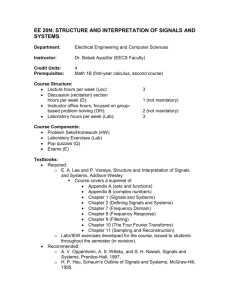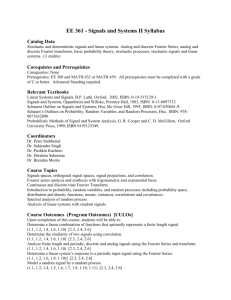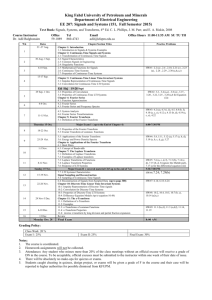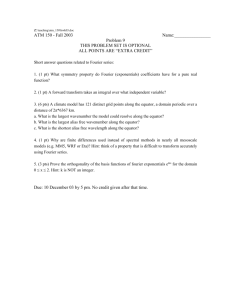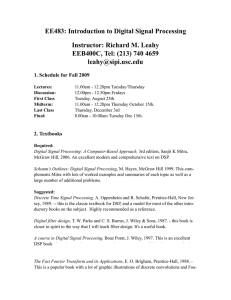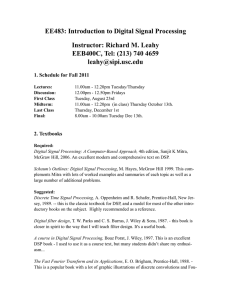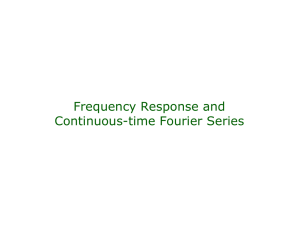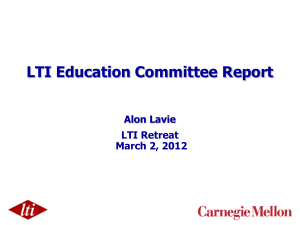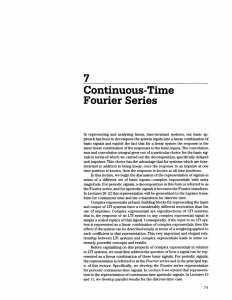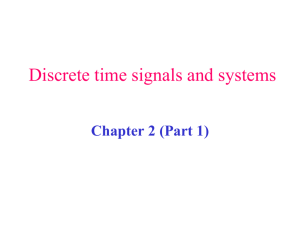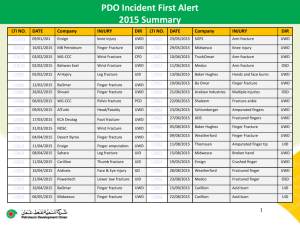Word - Electrical Engineering & Computer Sciences
advertisement
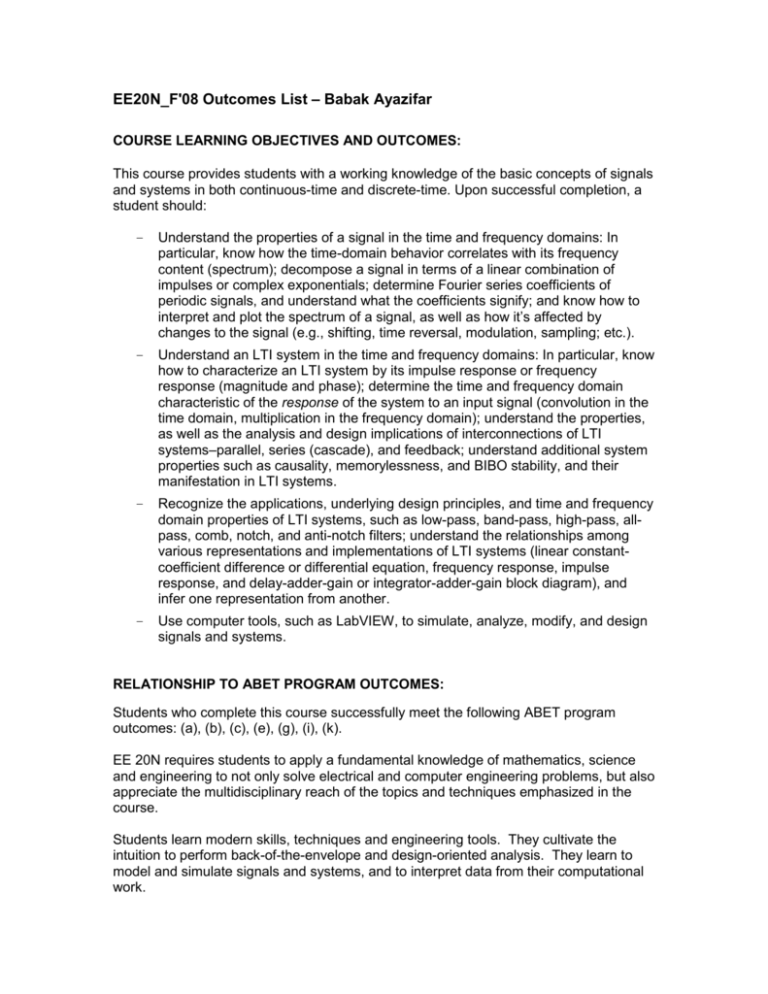
EE20N_F'08 Outcomes List – Babak Ayazifar COURSE LEARNING OBJECTIVES AND OUTCOMES: This course provides students with a working knowledge of the basic concepts of signals and systems in both continuous-time and discrete-time. Upon successful completion, a student should: – Understand the properties of a signal in the time and frequency domains: In particular, know how the time-domain behavior correlates with its frequency content (spectrum); decompose a signal in terms of a linear combination of impulses or complex exponentials; determine Fourier series coefficients of periodic signals, and understand what the coefficients signify; and know how to interpret and plot the spectrum of a signal, as well as how it’s affected by changes to the signal (e.g., shifting, time reversal, modulation, sampling; etc.). – Understand an LTI system in the time and frequency domains: In particular, know how to characterize an LTI system by its impulse response or frequency response (magnitude and phase); determine the time and frequency domain characteristic of the response of the system to an input signal (convolution in the time domain, multiplication in the frequency domain); understand the properties, as well as the analysis and design implications of interconnections of LTI systems–parallel, series (cascade), and feedback; understand additional system properties such as causality, memorylessness, and BIBO stability, and their manifestation in LTI systems. – Recognize the applications, underlying design principles, and time and frequency domain properties of LTI systems, such as low-pass, band-pass, high-pass, allpass, comb, notch, and anti-notch filters; understand the relationships among various representations and implementations of LTI systems (linear constantcoefficient difference or differential equation, frequency response, impulse response, and delay-adder-gain or integrator-adder-gain block diagram), and infer one representation from another. – Use computer tools, such as LabVIEW, to simulate, analyze, modify, and design signals and systems. RELATIONSHIP TO ABET PROGRAM OUTCOMES: Students who complete this course successfully meet the following ABET program outcomes: (a), (b), (c), (e), (g), (i), (k). EE 20N requires students to apply a fundamental knowledge of mathematics, science and engineering to not only solve electrical and computer engineering problems, but also appreciate the multidisciplinary reach of the topics and techniques emphasized in the course. Students learn modern skills, techniques and engineering tools. They cultivate the intuition to perform back-of-the-envelope and design-oriented analysis. They learn to model and simulate signals and systems, and to interpret data from their computational work. Problem sets and exams are designed to probe a thorough understanding of fundamental concepts and to de-emphasize rote algebraic manipulation. Exam problems insist on refined and to-the-point responses; limited space is allocated for each problem to encourage students to think more clearly and logically, and to articulate their responses efficiently and without clutter. The various components of the course encourage students to think graphically and draw, before they reach for mathematical formulae. Lectures, discussion sections, labs, and instructor’s office hours promote group work by engaging the students in a collaborative learning environment where they divide into groups of 3-5 students and discuss the solutions to the various problems posed to them. In discussion sections and office hours, students are asked to present their solutions to their peers on the board, to guide discussion among their peers by asking each other questions and assisting each other toward solutions. Recognizing that team work is an integral part of engineering practice, the homework policy encourages collaborative groups of up to five students. TOPICS COVERED: Mathematical Foundations – Sets and functions; Fundamentals of mathematical logic; Complex algebra (including complex-valued functions); Basic linear algebra (matrix-vector manipulations of 2x2 matrices; Vector-space concepts (e.g., basis, dimension, inner products, orthogonal basis expansions). Signals – Signals as functions: continuous time, discrete time; Signals as vectors in an appropriately-defined vector space having an appropriately-defined inner product; Orthogonality of signals; Two-dimensional space continuum; Discrete-space: discrete time and continuous space, discrete time and mixed space, discrete time and space, discrete events, discrete events and discrete time; Sequences. Sinusoids – Periodic signals, sinusoids-phase and amplitude, complex numbers, complex signals, complex exponentials; Phasors, amplitude modulation, frequency modulation. Spectrum – Summing sinusoids, approximating periodic signals, harmonics and musical sounds, beat notes, two-dimensional sinusoids; Approximating images. Sampling – Analog-to-digital conversion, aliasing, downsampling, digital-toanalog conversion, upsampling, oversampling CD players. Systems – Filters, Running average filter, Two-dimensional running average filter, FIR filters; IIR filters; Linearity; Time invariance; Causality; Memory; Impulse response; Convolution. Difference-equation representations of LTI systems. Frequency Response and Filtering – Sinusoidal input, complex sinusoidal input, transfer function; Filtering audio signals, blurring and sharpening images. Fourier Series and Transforms – Fourier series using vector-space concepts; Signals viewed as vectors; Harmonically-related sinusoids and complex exponentials are viewed as orthogonal vectors in an appropriately-defined vector space; Discrete Fourier series (DFS/DFT); Continuous-time Fourier series (FS); Discrete-time Fourier transform (DTFT); Continuous-time Fourier transform (CTFT). Spectrum Analysis – Spectra of periodic and aperiodic signals; Time and frequency sampling; Amplitude modulation; Spectrograms. Interconnections of Systems: Parallel, Cascade, and Feedback; implications of interconnected LTI systems for their time-domain and frequency-domain behaviors. Miscellaneous Topics – Hard limiting; Edge detection; Fractals and chaos; Noise in musical sounds and images.
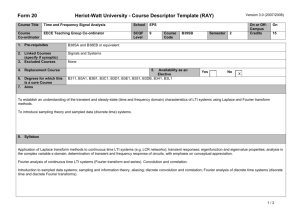
![DsP_0a [Compatibility Mode]](http://s2.studylib.net/store/data/018350832_1-b82300ad0f065413bb5669116d904fa1-300x300.png)

